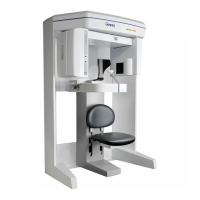
Do you have a question about the Gendex GX CB-500 and is the answer not in the manual?
| Brand | Gendex |
|---|---|
| Model | GX CB-500 |
| Category | Medical Equipment |
| Language | English |
Overview of the Cone Beam Volumetric Tomography and Panoramic X-ray device.
General guidelines for maintaining system safety for operators and patients.
Outlines essential precautions for safe operation and handling of the equipment.
Details risks and safety measures related to electrical components and installation.
Addresses risks associated with moving parts and mechanical operations.
Warns about the dangers of laser beams and necessary precautions.
Emphasizes the dangers of X-rays and the importance of observing safety procedures.
Lists measures to protect operators and patients from radiation exposure.
Details the function of emergency stops, warning systems, and interlocks.
Explains the function and use of emergency stop buttons for immediate system halt.
Explains how interlocks prevent X-ray operation when safety conditions are not met.
Provides steps for safely removing a patient from the chair in an emergency.
Identifies labels warning about laser radiation hazards and required precautions.
Highlights labels warning about X-ray hazards and unauthorized use.
Identifies labels warning about pinch point hazards and keeping hands clear.
Lists and describes error messages that the system may display.
Details the functions of the ON, OFF, EMERGENCY STOP, and SCAN buttons on the control box.
Explains the function of the patient-operated emergency stop button.
Describes the alignment lights and chair adjustment features on the panel.
Provides step-by-step instructions for powering up the scanner and workstation.
Details the procedure for safely shutting down the scanner and computer workstation.
Details the process of assembling the device, including unpacking and lifting.
Provides steps for correctly leveling the Gantry for optimal performance.
Guides the user through aligning the patient chair for accurate imaging.
Explains the use of alignment lasers for positioning and calibration.
Details how to adjust the centerline laser for right-to-left and angle.
Provides instructions for adjusting the crosshair laser for horizontal, vertical, and rotation.
Describes the weekly procedure for calibrating the system's panel.
Details the annual calibration process for the collimators to ensure image quality.
Explains the annual calibration for geometry to ensure optimal image quality.
Outlines the process for performing the QA phantom test to check spatial resolution.
Explains the procedure for measuring Hounsfield Units to check density consistency.
Details the noise and uniformity test using a water phantom.
Describes the annual check of X-ray source output and timer accuracy.
Guides on checking and adjusting the detector pivot for proper alignment.
Guides on setting up network support, including providing storage and installing services.
Guides on configuring the Sweeper service startup type and logon credentials.
Discusses actions to take in case of network failures and fallback operations.
Details how the system handles and recovers from startup network access issues.
Explains fallback procedures for VisionQ when network access is lost.
Outlines fallback procedures for standalone Vision when network access is lost.
Describes system behavior and indicators when network failures occur during operation.
Explains the two methods for importing scheduled patient data into VisionQ.
Guides on installing necessary components and setting up the import interface.
Details the steps to configure the DICOM Worklist interface for data import.
Outlines the steps to configure the Practice Management interface for data import.
Outlines daily, monthly, and yearly preventive maintenance tasks for the owner/user.
Continues the instructions for querying and retrieving images from remote servers.